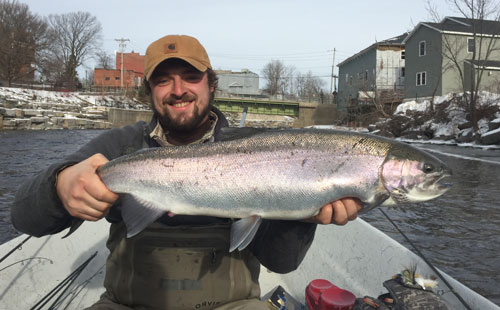
As old-man winter loosens his grip on New York, my mind wanders to bitterly cold, early-morning sunrises set to the soundtrack of the slow, steady hum of a boat engine. It’s finally time to troll mighty Lake Ontario.
Another, consecutive, mild winter has many anglers excited for this coming season. Ice cover held below 35% through 2016, which is a sharp contrast to 2014 and 2015, which had ice cover averages above 88%. The limited ice lends a hand to the survival of our gamefish, as well as our baitfish, namely the alewife.
As a member of the Coldsteel Sportfishing fleet (www.coldsteelsportfishing.com), my home port is Oswego, NY. Generally speaking, brown trout are our primary target early in the trolling season. When pursuing our square-tailed friends, I am searching for two things; warmer/stained water and baitfish. These conditions are often found at tributary stream mouths, especially after a melt or precipitation.

When faced with clear water and/or a bright sunny day, I find the natural color tones suit me well. A simple black and white or silver often produces. I also find that a higher trolling speed will illicit strikes, as fish may be reacting and chasing. This also helps you to explore, potentially stumbling upon better water color or a slight jump in temperature.

Off-shore, I like to keep a spread heavy in spoons, throughout a wide-range of the water column. Leadcore off of planer boards is the chief producer, more often than not. I also keep a copper long-line off the stern. Typically, I have a large flasher with an A-TOM-MIK trolling fly behind it, you never know when you’ll find a spring king with an appetite. Checking, changing and adjusting your lure selection is important. I like to keep a high trolling speed when off-shore, as I am searching for fish.
So, as the days grow a bit longer and warmers, prepare to dust off the trolling rods and re-organize the tackle boxes. The challenges and rewards of fishing Lake Ontario for another season are just around the corner.
